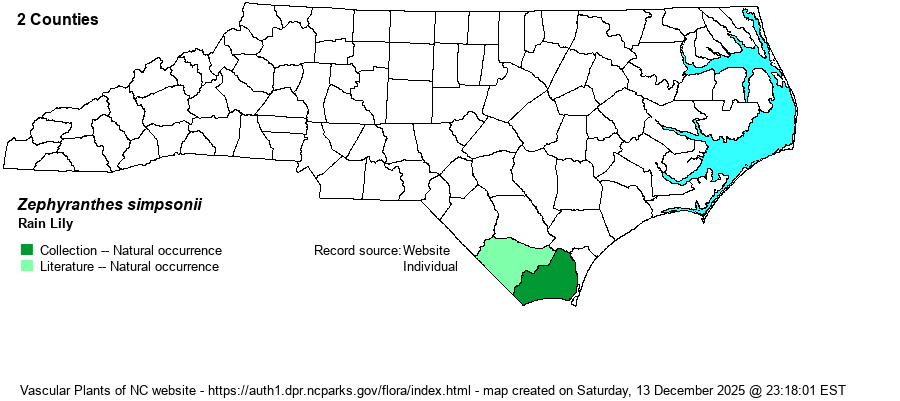| Author | Chapman | |
| Distribution | Formerly known only from Brunswick County, but recently (2024) a photo was posted on iNaturalist in neighboring Columbus County by Brandon Wheeler. The NC NHP has about 20 records for the coastal portions of Brunswick County, almost all in the southwestern corner of the county.
This species occurs along the Southeastern coast, for the most part -- southern NC south through FL, and then west to MS. | |
| Abundance | Fairly common in the Calabash/Sunset Beach area, where many records. Very rare elsewhere in the county and in Columbus County, where found near the Waccamaw River. This is a State Endangered species. Despite around 20 records, most populations are small or are on roadsides, and thus the NC NHP's State Rank of S1 is justified. | |
| Habitat | The species in NC occurs on sandy or other dry to mesic soils, almost always with a marl/calcareous influence to the soil. Most locations are on roadsides, but some are in or along the edges of coastal fringe forests. | |
| Phenology | Blooms in April and May, and fruits in May and June. | |
| Identification | This species closely resembles the much more common Atamasco Lily (Z. atamasco). Like that species, it has a cluster of shiny strap-like leaves about 10 inches long and about 1/4-inch wide, and a flowering stalk to about 1 foot tall. The flowers are white to pink, turning dark pink. In general, the flowers do average a bit less frequently pure white than those of Z. atamasco. However, the main visual feature is that the tepals tend to be rather stiff/straight and ascending, and not obviously gracefully arcing back as in the more vase-like Z. atamasco. A more technical character is that on Z. simpsonii the style and stigma are as long or shorter than the anthers, whereas in Z. atamasco those female parts extend beyond the anthers. This showy species is not hard to find by driving around the streets on the mainland side of Sunset Beach in the spring, though you may have to be in the narrow window of the flowering period to know for certain you have this species. Sadly, probably none of the sites are in conservation areas, and thus protection of the species depends on coordination of various agencies with the N.C. Department of Transportation (in terms of mowing, widening, and other maintenance activities). | |
| Taxonomic Comments | Weakley (2018) states that "The disjunct populations in NC and SC may differ from Z. simpsonii (sensu stricto) of s. GA and c. and s. peninsular FL, and need additional study".
| |
| Other Common Name(s) | Florida Atamasco-lily, Red-margined Atamasco-lily, Simpson's Lily, Simpson's Zephyr-lily, and several others. Sadly, this species has no well established common name. | |
| State Rank | S1 | |
| Global Rank | G2G3 | |
| State Status | E | |
| US Status | | |
| USACE-agcp | FAC link |
| USACE-emp | FAC link |

